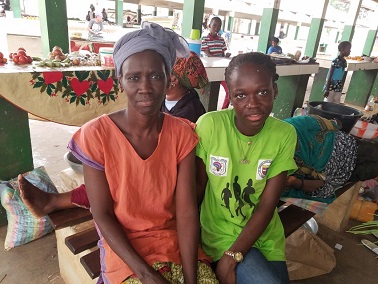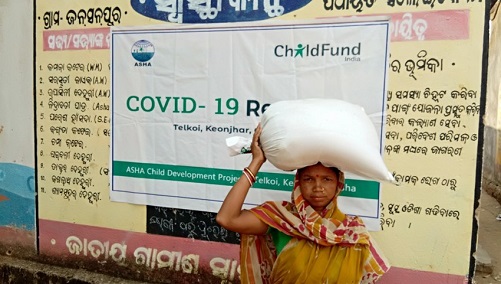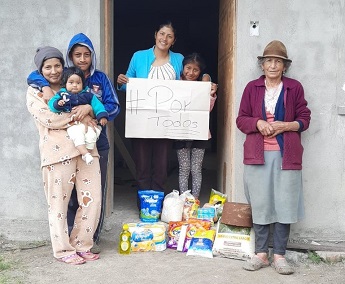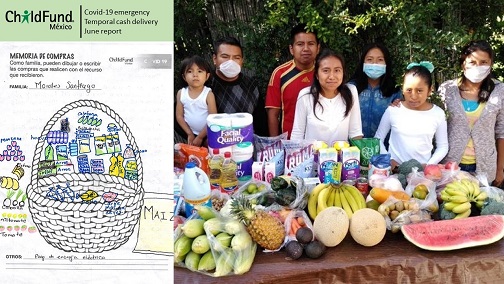Site will be
unavailable for maintenance from June. 4, 11:30 p.m., to June 5, 12:30 a.m. ET. Thank you for your
patience!
Cash-based assistance: What is it, how does it work, and why does ChildFund use it to respond to humanitarian emergencies?
By Ben Phillips, Director - Emergency Management Unit, ChildFund International Posted on 09/16/2020
My first experience working in humanitarian response was in Sierra Leone in the late ’90s, helping people who were affected by that country’s civil war. At the time, I worked for a large, U.S.-based nonprofit that provided food and other aid to people who had lost their homes in the fighting. I know that the help we provided kept thousands of people alive in the most desperate of circumstances, but reflecting on that experience now, I believe there were some drawbacks to our approach:
Lots of money was spent on transportation, warehouse rentals and other logistical/management costs needed to move, store and distribute thousands of tons of food each year.
- A fair amount of food got lost in handling as bags got torn during loading and offloading, not to mention losses from rodents and water damage while in storage.
- The people we were trying to help had to spend hours waiting in line to get their food rations, often under a hot sun, and then walk for miles carrying heavy bags back to their temporary homes in the camps.
- When new displacements happened (for example, if a town was attacked by armed rebels), it took time to organize transport and distribution to get food to a new group of people who urgently needed it.
- Some of the food we gave to people ended up for sale in local shops and restaurants, because in some cases, what people needed along with food was money to take care of other urgent household needs.
At that time, it did not occur to me or my colleagues that we might have been able to achieve the same or better results in a much different way. But two decades later, ChildFund and many other organizations providing humanitarian assistance have learned that it is often possible to meet people’s most urgent, lifesaving needs in a way that is faster, more efficient, more flexible and more respectful than traditional, in-kind distributions: We give them cash!

Jabu, 14, sits with her mom, Lissa, at a market in The Gambia. When COVID-19 hit, Lissa had to stop working because the market closed, so she couldn’t make money to buy food or iron sheets to fortify their roof before the rainy season. Thanks to a cash transfer from ChildFund, the family was able to buy exactly what they needed.
So, what is cash assistance?
Those of us experiencing the COVID-19 pandemic in the U.S. can understand the purpose and concept of cash assistance. Early on in the crisis, when many people had lost their jobs or had reduced income, our own government helped by sending cash payments to nearly everyone below a certain income level. People who received those funds – including my own family – could use them to pay for what they needed most. For some, that meant buying food and other basic household supplies. Others used it to pay the rent or mortgage to stay in their homes, or bought laptops so their kids could keep up their studies online.
Despite some hiccups (as can be expected with such a massive undertaking), the majority of U.S. households got the funds in their bank accounts within a fairly short period – much faster than if the government had tried to purchase massive quantities of food, laptops and other items and distribute these to each affected family; not to mention that it would have been impossible to design such a program providing exactly what each family most needed at that time.
The same logic applies when ChildFund and other organizations help people affected by different kinds of emergencies in other countries – whether these emergencies are natural disasters, conflicts or long-term crises like the current COVID-19 situation. Most often, it is faster and more efficient to give people cash they can use to buy exactly what they need, rather than trying to purchase everything centrally and then organize transportation, storage and distribution. After a recent social conflict in Kenya that destroyed several people’s homes, ChildFund was able to send cash to the affected community the very next day – much faster than we could have managed to purchase and deliver in-kind food and other items. Less funds spent on transport, logistics and management also means we can help more people using the same amount of available resources.
Cash assistance is also more respectful, recognizing that each family understands their own needs better than anyone else does. It would be extremely difficult for ChildFund – or any organization – to buy and distribute items that met each household’s full set of food, health, shelter, education, transportation and other needs.
Another advantage of cash assistance is that the families who receive money will likely spend it in local markets, stimulating the local economy and multiplying the benefit to other individuals, like small shopkeepers and farmers.
Is it always better to give cash rather than in-kind aid?
Not necessarily. In some situations right after a disaster, local markets won’t have goods available to buy, and traders might not be able to bring in new supplies quickly – especially if roads and bridges are damaged, making transportation difficult. In those cases, giving people cash would not help them to buy needed items, and in fact could cause inflation as people use their funds to bid up the prices of the few goods available.
In that situation, despite the logistical challenges and other disadvantages I mentioned before, it would be better for an organization to purchase food and other needed supplies from elsewhere and distribute them to families in need. For example, during the current COVID-19 response, ChildFund has organized and distributed food baskets to some communities in Honduras and Guatemala, where severe restrictions on movement make it very difficult for people to reach shops where goods are available.

A woman carries a bag of food from a ChildFund COVID-19 food distribution in India.
Another common issue is that even if staple foods and basic items are available in local shops, specialized products that are critical to people’s health or safety might not be. In those cases, it may be best to combine cash-based aid with in-kind distributions of specific products. When I worked in Tajikistan in 2008, people were affected by extreme winter cold combined with shortages of food, gas and electricity. One useful item was an insulated thermos container for keeping water hot throughout the day, so families could avoid using scarce firewood to reheat water several times for tea. That product was not available in local shops, so the organization I worked for at the time purchased it centrally and distributed in communities – in addition to cash that people used to buy food, warm clothing, blankets and other locally available goods.
Serious, responsible organizations like ChildFund who are carrying out cash-based assistance programs in response to emergencies always start with an assessment of people’s needs, followed by a market assessment to see what is available for purchase. With that information, we can design a response that is appropriate, fast and effective.
But isn’t it risky to give cash?
All forms of humanitarian aid carry risks, including risks to the security of our staff, financial mismanagement and possible exploitation or abuse of program participants. These risks take different forms depending on whether the aid is delivered as cash or in kind, but there is no evidence that cash-based aid programs are inherently more risky than other types of assistance. ChildFund and other organizations setting up cash assistance programs put in place measures to mitigate those risks, such as transparent beneficiary targeting and registration, community-based monitoring systems, careful tracking of receipts, proper distribution processes, whistleblower/complaints procedures, and regular reviews and audits.
What if people use their cash to buy the “wrong” things, like drugs and alcohol, instead of food for their children?
Many people have asked this kind of question since organizations first began using cash for humanitarian response on a large scale. Those concerns led to quite a bit of scrutiny, and research studies were carried out in many different contexts to analyze the outcomes of cash assistance programs – in particular, to analyze recipients’ use of the funds. The findings are clear across the board: While some percentage of funds may be used for expenses which are not seen as beneficial, this percentage is quite small compared to what organizations would need to spend on management and logistics to purchase and deliver all of the needed items in kind.
To look at this question from another angle: People who receive in-kind aid, like food, could (and likely do, in some cases) sell a portion of that food if they need or want money to purchase other goods – including harmful ones. In general, though, families affected by crises have a much better understanding of their own needs than ChildFund or any organization’s staff do. Our cash-based responses to the COVID-19 pandemic and other emergencies target families who lack resources due to the impact of the crisis – rather than those who are suffering due to other reasons such as alcoholism or drug addiction, and therefore may need a different type of help.
How does ChildFund decide who receives cash assistance?
The resources we have available are never enough to help everyone facing need – let alone everyone who feels like they could use some extra cash – so ChildFund must take extra care to target the people who are most vulnerable to the crisis at hand. To avoid potential misunderstandings and conflicts, our local partners work together with community members to agree on clear, transparent criteria on who should get priority for cash aid. In different places, those criteria might include overall poverty level, loss of employment or income, family size, age of children in the household, elderly or single parent-headed households or households with disabled family members.

In Ecuador, this family of six received a cash transfer, which they used to buy hygiene supplies and food. Elsa, the mother, used to sell ice cream and make dresses, but due to COVID-19 she’s unable to earn income.
How much money does ChildFund give to each targeted family?
ChildFund sets the transfer amount, frequency and duration based on an analysis of household needs. We develop an estimate of basic minimum expenses versus an estimate of existing resources to get the net amount families will need. In most countries, ChildFund conducts this exercise in coordination with other humanitarian organizations delivering cash assistance to families affected by the same crisis – often organized into a country “Cash Working Group.” This helps avoid possible misunderstandings and conflicts if some agencies give larger amounts than others. In some countries, national government authorities set the amounts for cash transfers, and ChildFund follows those policies.
How does ChildFund deliver cash to targeted households?
Besides assessing people’s needs and local market conditions, ChildFund also looks at what financial services are available to help get the money to families in need, along with people’s familiarity and comfort level with using those services. Depending on what is possible in each community, ChildFund may use local bank branches, ATMs, cooperatives, credit unions, mobile money providers, check payments or physical cash distribution. We prefer to use electronic means, like mobile money and ATMs, because they are safer and easier to track, but if no alternatives are available, we distribute physical banknotes directly to households. When ChildFund does this, our staff follow strict protocols to keep both security risks and COVID-19 infection risks to a minimum.
Does ChildFund monitor what happens to the cash once it is delivered?
At the very minimum, ChildFund takes steps to ensure that all cash was received by the intended families who needed support. That is easiest for mobile and other electronic means of transfer, which allow instantaneous tracking using an online system. But regardless of how funds are delivered, ChildFund carries out regular spot checks to verify that the right people got the right amounts. In places where home visits are not currently advisable due to the COVID-19 pandemic situation, ChildFund staff use phone calls to verify that people received their cash on schedule.
Besides verifying receipts, ChildFund also monitors what people did with their cash. While we do not intend to restrict or limit what people spend their funds on, learning about their choices helps us to better understand their situations and the benefits of our assistance. ChildFund has also put in place a global outcomes study, collecting information from selected communities on people’s situations before and after receiving the cash. We ask questions like how many meals they ate per day, how often family members went to bed hungry, and other key data points that help us improve our cash assistance programs.

In this drawing and photo from Mexico, two families show how they used the funds they got from ChildFund. Besides a variety of healthy food items, you can see purchases of hygiene items and an electricity bill payment.
Has ChildFund used cash assistance in other programs before COVID-19?
Yes! ChildFund used cash to help families affected by the Ebola outbreak in Liberia, political conflict causing displacement in The Gambia, several tropical storms in The Philippines, an earthquake in Indonesia and mudslides in Sierra Leone and Sri Lanka. In some of these situations, families used the cash to meet their basic, immediate needs in the aftermath of disaster; in others, it enabled them to rebuild their homes or re-start small business activities. ChildFund also used cash as part of a longer-term, family strengthening program in Uganda, helping poor, vulnerable families to stay together rather than sending their children to live elsewhere due to economic pressure. We built off those different experiences to design a much larger cash assistance program for the COVID-19 pandemic; as of August 10, 2020, we had delivered a total of $3,580,231 to 115,002 families in 16 countries.
Will ChildFund continue giving cash assistance once the COVID-19 pandemic is over?
Our longer-term development programs are designed to build self-sufficiency. Hopefully, once the COVID-19 crisis subsides, most of the affected families will be able to return to their previous employment, small business, farming, or other way of earning a living. Many of the countries and regions where we work are vulnerable to frequent disasters such as floods, earthquakes, typhoons, droughts and even political conflicts; when responding to those future crises, we will continue to use cash as an important tool when it is appropriate.
Where can I learn more about cash-based assistance?
The Cash Learning Partnership (CaLP) brings together many different actors involved in humanitarian cash-based assistance. The CaLP website has excellent learning resources, including e-learning courses, a Programme Quality Toolbox for cash assistance, and a searchable research database with reports, studies, blog posts and other publications from all over the world.
The International Red Cross and Red Crescent Movement has developed a Cash in Emergencies Toolkit which includes formats, templates and guidance documents used for designing, preparing, implementing and monitoring cash assistance programs. ChildFund made extensive use of this toolkit in developing the cash component of its COVID-19 response.
How can I help?
Thanks for asking. As we continue to respond to the COVID-19 pandemic and any other crises that arise in the places where we work, you can always help by donating to our emergency fund. Speaking from experience, the faster we’re able to get funds to children and families after an emergency (whether it’s for in-kind support or cash-based assistance), the better chance they have at surviving, and recovering after the emergency has subsided. Your support is vital to our work, and I’m extremely grateful.
Loading...


